Financial Reporting and Consolidated Financial Statements Analysis
VerifiedAdded on 2021/06/18
|12
|2899
|176
Report
AI Summary
This comprehensive report delves into the realm of financial reporting and consolidated financial statements, offering a detailed analysis of accounting practices. The report begins with an executive summary outlining the key objectives, which include assessing the qualitative characteristics of financial reporting, evaluating compliance with environmental regulations, and understanding the preparation of consolidated financial statements, with a specific focus on the role of subsidiaries. Part A of the report examines the financial reporting of Woolworths Limited, evaluating the relevance and comparability of its financial statements, as well as its environmental reporting practices and the adequacy of information disclosed. The report then provides recommendations to strengthen these areas. Part B focuses on the accounting for pre-acquisition entries, explaining their purpose, as well as discussing dividend treatment and the effects of goodwill in consolidated financial statements. The analysis provides a clear understanding of the accounting treatments for pre and post acquisition dividends.
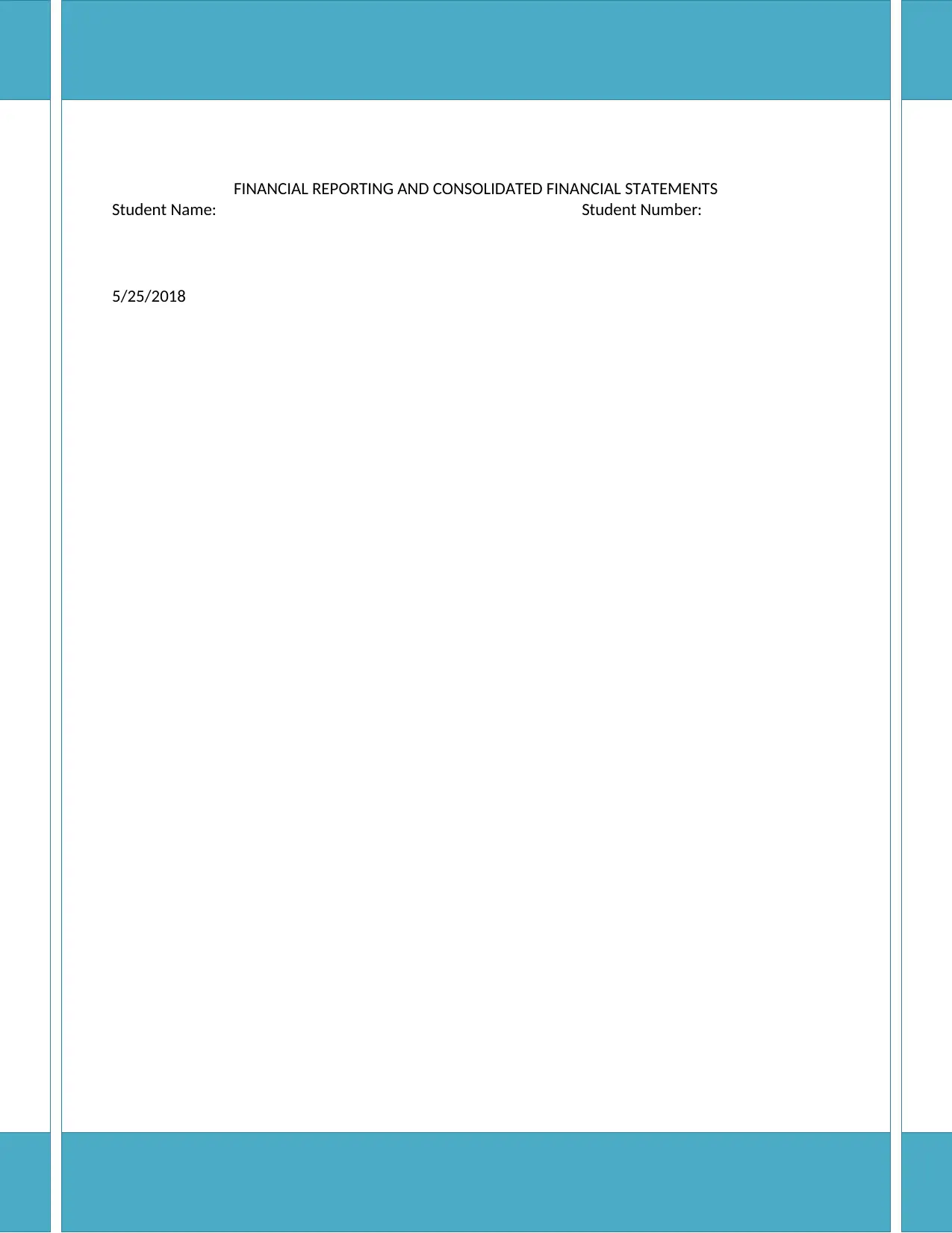
FINANCIAL REPORTING AND CONSOLIDATED FINANCIAL STATEMENTS
Student Name: Student Number:
5/25/2018
Student Name: Student Number:
5/25/2018
Paraphrase This Document
Need a fresh take? Get an instant paraphrase of this document with our AI Paraphraser
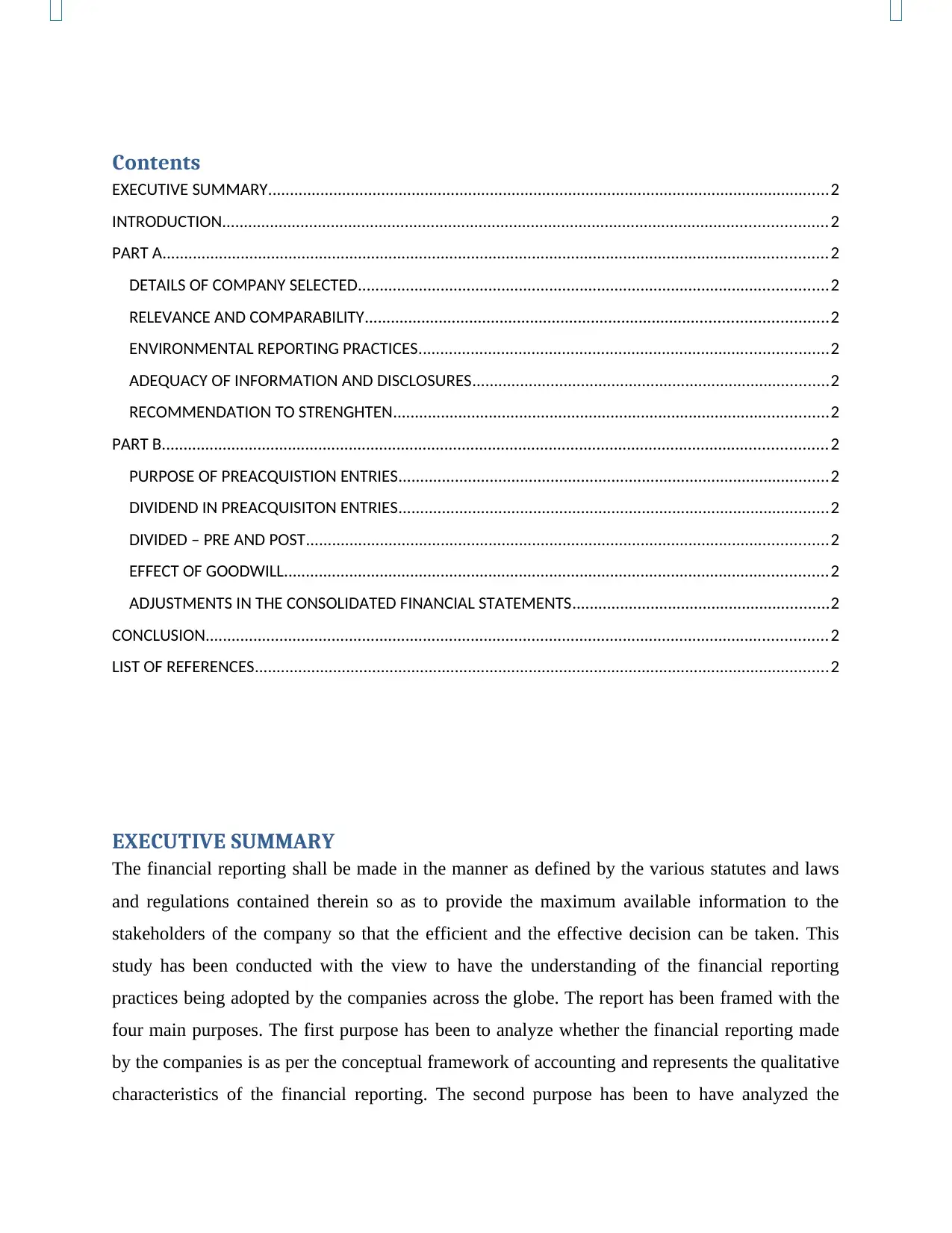
Contents
EXECUTIVE SUMMARY.................................................................................................................................2
INTRODUCTION...........................................................................................................................................2
PART A.........................................................................................................................................................2
DETAILS OF COMPANY SELECTED............................................................................................................2
RELEVANCE AND COMPARABILITY..........................................................................................................2
ENVIRONMENTAL REPORTING PRACTICES..............................................................................................2
ADEQUACY OF INFORMATION AND DISCLOSURES..................................................................................2
RECOMMENDATION TO STRENGHTEN....................................................................................................2
PART B.........................................................................................................................................................2
PURPOSE OF PREACQUISTION ENTRIES...................................................................................................2
DIVIDEND IN PREACQUISITON ENTRIES...................................................................................................2
DIVIDED – PRE AND POST........................................................................................................................2
EFFECT OF GOODWILL.............................................................................................................................2
ADJUSTMENTS IN THE CONSOLIDATED FINANCIAL STATEMENTS...........................................................2
CONCLUSION...............................................................................................................................................2
LIST OF REFERENCES....................................................................................................................................2
EXECUTIVE SUMMARY
The financial reporting shall be made in the manner as defined by the various statutes and laws
and regulations contained therein so as to provide the maximum available information to the
stakeholders of the company so that the efficient and the effective decision can be taken. This
study has been conducted with the view to have the understanding of the financial reporting
practices being adopted by the companies across the globe. The report has been framed with the
four main purposes. The first purpose has been to analyze whether the financial reporting made
by the companies is as per the conceptual framework of accounting and represents the qualitative
characteristics of the financial reporting. The second purpose has been to have analyzed the
EXECUTIVE SUMMARY.................................................................................................................................2
INTRODUCTION...........................................................................................................................................2
PART A.........................................................................................................................................................2
DETAILS OF COMPANY SELECTED............................................................................................................2
RELEVANCE AND COMPARABILITY..........................................................................................................2
ENVIRONMENTAL REPORTING PRACTICES..............................................................................................2
ADEQUACY OF INFORMATION AND DISCLOSURES..................................................................................2
RECOMMENDATION TO STRENGHTEN....................................................................................................2
PART B.........................................................................................................................................................2
PURPOSE OF PREACQUISTION ENTRIES...................................................................................................2
DIVIDEND IN PREACQUISITON ENTRIES...................................................................................................2
DIVIDED – PRE AND POST........................................................................................................................2
EFFECT OF GOODWILL.............................................................................................................................2
ADJUSTMENTS IN THE CONSOLIDATED FINANCIAL STATEMENTS...........................................................2
CONCLUSION...............................................................................................................................................2
LIST OF REFERENCES....................................................................................................................................2
EXECUTIVE SUMMARY
The financial reporting shall be made in the manner as defined by the various statutes and laws
and regulations contained therein so as to provide the maximum available information to the
stakeholders of the company so that the efficient and the effective decision can be taken. This
study has been conducted with the view to have the understanding of the financial reporting
practices being adopted by the companies across the globe. The report has been framed with the
four main purposes. The first purpose has been to analyze whether the financial reporting made
by the companies is as per the conceptual framework of accounting and represents the qualitative
characteristics of the financial reporting. The second purpose has been to have analyzed the
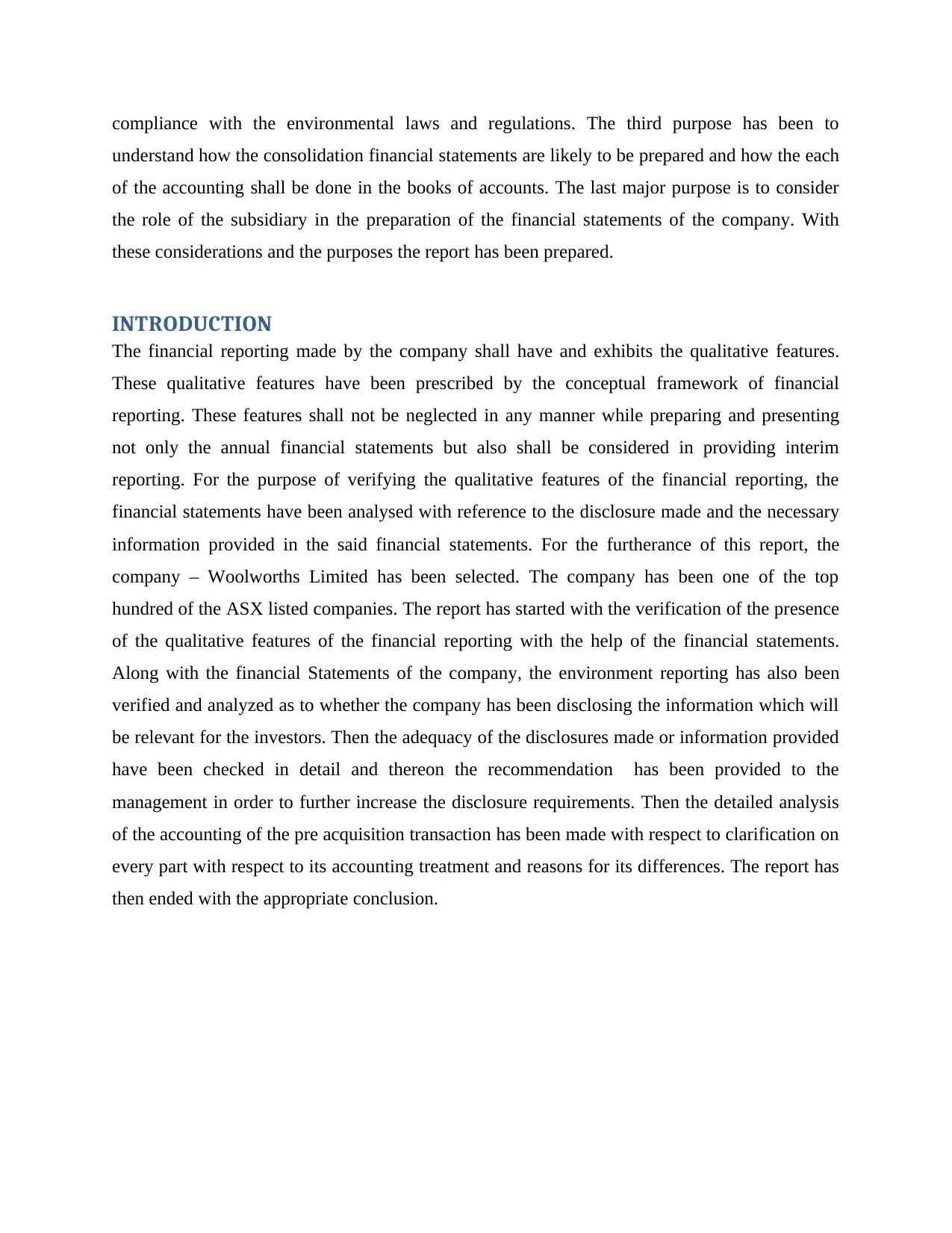
compliance with the environmental laws and regulations. The third purpose has been to
understand how the consolidation financial statements are likely to be prepared and how the each
of the accounting shall be done in the books of accounts. The last major purpose is to consider
the role of the subsidiary in the preparation of the financial statements of the company. With
these considerations and the purposes the report has been prepared.
INTRODUCTION
The financial reporting made by the company shall have and exhibits the qualitative features.
These qualitative features have been prescribed by the conceptual framework of financial
reporting. These features shall not be neglected in any manner while preparing and presenting
not only the annual financial statements but also shall be considered in providing interim
reporting. For the purpose of verifying the qualitative features of the financial reporting, the
financial statements have been analysed with reference to the disclosure made and the necessary
information provided in the said financial statements. For the furtherance of this report, the
company – Woolworths Limited has been selected. The company has been one of the top
hundred of the ASX listed companies. The report has started with the verification of the presence
of the qualitative features of the financial reporting with the help of the financial statements.
Along with the financial Statements of the company, the environment reporting has also been
verified and analyzed as to whether the company has been disclosing the information which will
be relevant for the investors. Then the adequacy of the disclosures made or information provided
have been checked in detail and thereon the recommendation has been provided to the
management in order to further increase the disclosure requirements. Then the detailed analysis
of the accounting of the pre acquisition transaction has been made with respect to clarification on
every part with respect to its accounting treatment and reasons for its differences. The report has
then ended with the appropriate conclusion.
understand how the consolidation financial statements are likely to be prepared and how the each
of the accounting shall be done in the books of accounts. The last major purpose is to consider
the role of the subsidiary in the preparation of the financial statements of the company. With
these considerations and the purposes the report has been prepared.
INTRODUCTION
The financial reporting made by the company shall have and exhibits the qualitative features.
These qualitative features have been prescribed by the conceptual framework of financial
reporting. These features shall not be neglected in any manner while preparing and presenting
not only the annual financial statements but also shall be considered in providing interim
reporting. For the purpose of verifying the qualitative features of the financial reporting, the
financial statements have been analysed with reference to the disclosure made and the necessary
information provided in the said financial statements. For the furtherance of this report, the
company – Woolworths Limited has been selected. The company has been one of the top
hundred of the ASX listed companies. The report has started with the verification of the presence
of the qualitative features of the financial reporting with the help of the financial statements.
Along with the financial Statements of the company, the environment reporting has also been
verified and analyzed as to whether the company has been disclosing the information which will
be relevant for the investors. Then the adequacy of the disclosures made or information provided
have been checked in detail and thereon the recommendation has been provided to the
management in order to further increase the disclosure requirements. Then the detailed analysis
of the accounting of the pre acquisition transaction has been made with respect to clarification on
every part with respect to its accounting treatment and reasons for its differences. The report has
then ended with the appropriate conclusion.
⊘ This is a preview!⊘
Do you want full access?
Subscribe today to unlock all pages.

Trusted by 1+ million students worldwide
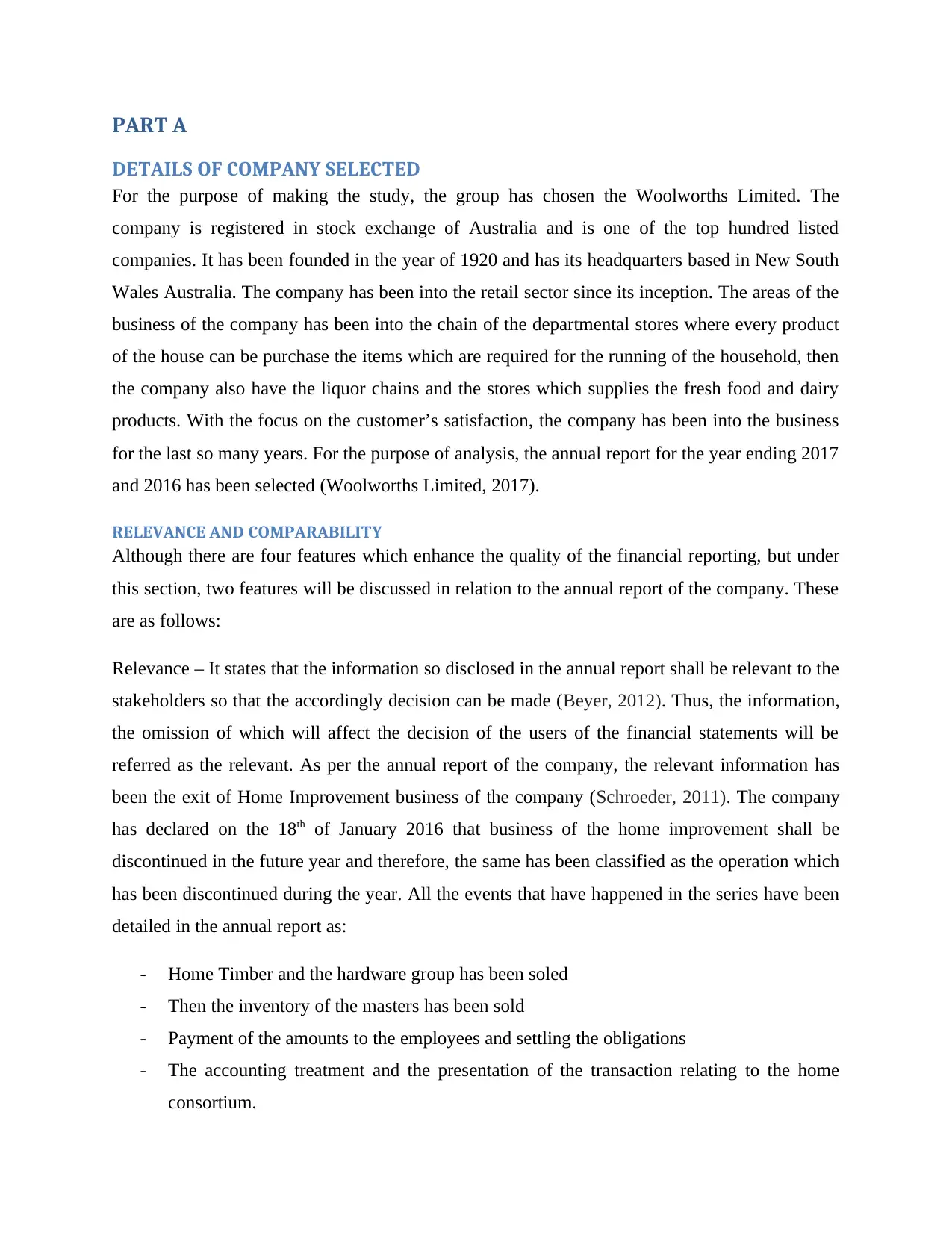
PART A
DETAILS OF COMPANY SELECTED
For the purpose of making the study, the group has chosen the Woolworths Limited. The
company is registered in stock exchange of Australia and is one of the top hundred listed
companies. It has been founded in the year of 1920 and has its headquarters based in New South
Wales Australia. The company has been into the retail sector since its inception. The areas of the
business of the company has been into the chain of the departmental stores where every product
of the house can be purchase the items which are required for the running of the household, then
the company also have the liquor chains and the stores which supplies the fresh food and dairy
products. With the focus on the customer’s satisfaction, the company has been into the business
for the last so many years. For the purpose of analysis, the annual report for the year ending 2017
and 2016 has been selected (Woolworths Limited, 2017).
RELEVANCE AND COMPARABILITY
Although there are four features which enhance the quality of the financial reporting, but under
this section, two features will be discussed in relation to the annual report of the company. These
are as follows:
Relevance – It states that the information so disclosed in the annual report shall be relevant to the
stakeholders so that the accordingly decision can be made (Beyer, 2012). Thus, the information,
the omission of which will affect the decision of the users of the financial statements will be
referred as the relevant. As per the annual report of the company, the relevant information has
been the exit of Home Improvement business of the company (Schroeder, 2011). The company
has declared on the 18th of January 2016 that business of the home improvement shall be
discontinued in the future year and therefore, the same has been classified as the operation which
has been discontinued during the year. All the events that have happened in the series have been
detailed in the annual report as:
- Home Timber and the hardware group has been soled
- Then the inventory of the masters has been sold
- Payment of the amounts to the employees and settling the obligations
- The accounting treatment and the presentation of the transaction relating to the home
consortium.
DETAILS OF COMPANY SELECTED
For the purpose of making the study, the group has chosen the Woolworths Limited. The
company is registered in stock exchange of Australia and is one of the top hundred listed
companies. It has been founded in the year of 1920 and has its headquarters based in New South
Wales Australia. The company has been into the retail sector since its inception. The areas of the
business of the company has been into the chain of the departmental stores where every product
of the house can be purchase the items which are required for the running of the household, then
the company also have the liquor chains and the stores which supplies the fresh food and dairy
products. With the focus on the customer’s satisfaction, the company has been into the business
for the last so many years. For the purpose of analysis, the annual report for the year ending 2017
and 2016 has been selected (Woolworths Limited, 2017).
RELEVANCE AND COMPARABILITY
Although there are four features which enhance the quality of the financial reporting, but under
this section, two features will be discussed in relation to the annual report of the company. These
are as follows:
Relevance – It states that the information so disclosed in the annual report shall be relevant to the
stakeholders so that the accordingly decision can be made (Beyer, 2012). Thus, the information,
the omission of which will affect the decision of the users of the financial statements will be
referred as the relevant. As per the annual report of the company, the relevant information has
been the exit of Home Improvement business of the company (Schroeder, 2011). The company
has declared on the 18th of January 2016 that business of the home improvement shall be
discontinued in the future year and therefore, the same has been classified as the operation which
has been discontinued during the year. All the events that have happened in the series have been
detailed in the annual report as:
- Home Timber and the hardware group has been soled
- Then the inventory of the masters has been sold
- Payment of the amounts to the employees and settling the obligations
- The accounting treatment and the presentation of the transaction relating to the home
consortium.
Paraphrase This Document
Need a fresh take? Get an instant paraphrase of this document with our AI Paraphraser
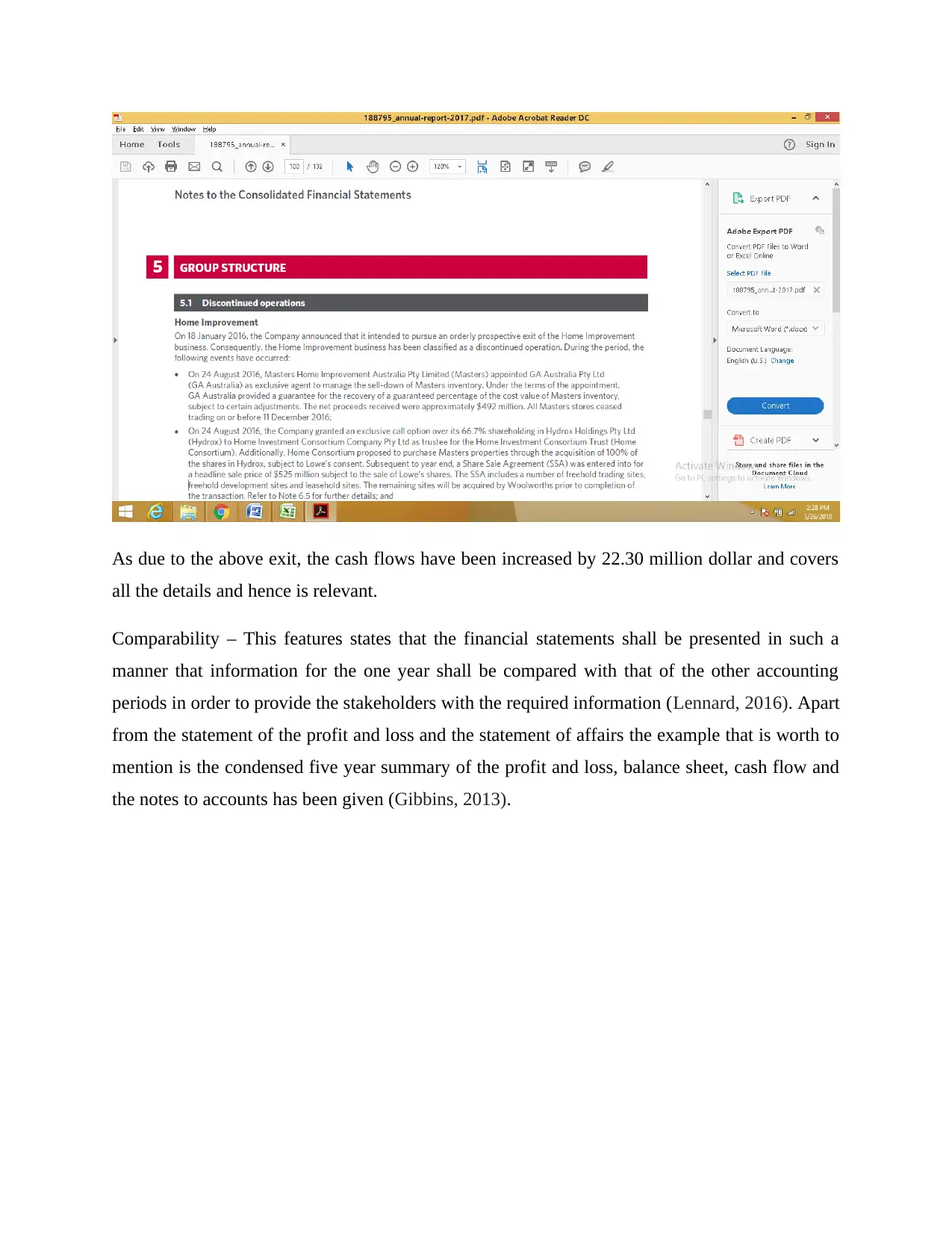
As due to the above exit, the cash flows have been increased by 22.30 million dollar and covers
all the details and hence is relevant.
Comparability – This features states that the financial statements shall be presented in such a
manner that information for the one year shall be compared with that of the other accounting
periods in order to provide the stakeholders with the required information (Lennard, 2016). Apart
from the statement of the profit and loss and the statement of affairs the example that is worth to
mention is the condensed five year summary of the profit and loss, balance sheet, cash flow and
the notes to accounts has been given (Gibbins, 2013).
all the details and hence is relevant.
Comparability – This features states that the financial statements shall be presented in such a
manner that information for the one year shall be compared with that of the other accounting
periods in order to provide the stakeholders with the required information (Lennard, 2016). Apart
from the statement of the profit and loss and the statement of affairs the example that is worth to
mention is the condensed five year summary of the profit and loss, balance sheet, cash flow and
the notes to accounts has been given (Gibbins, 2013).
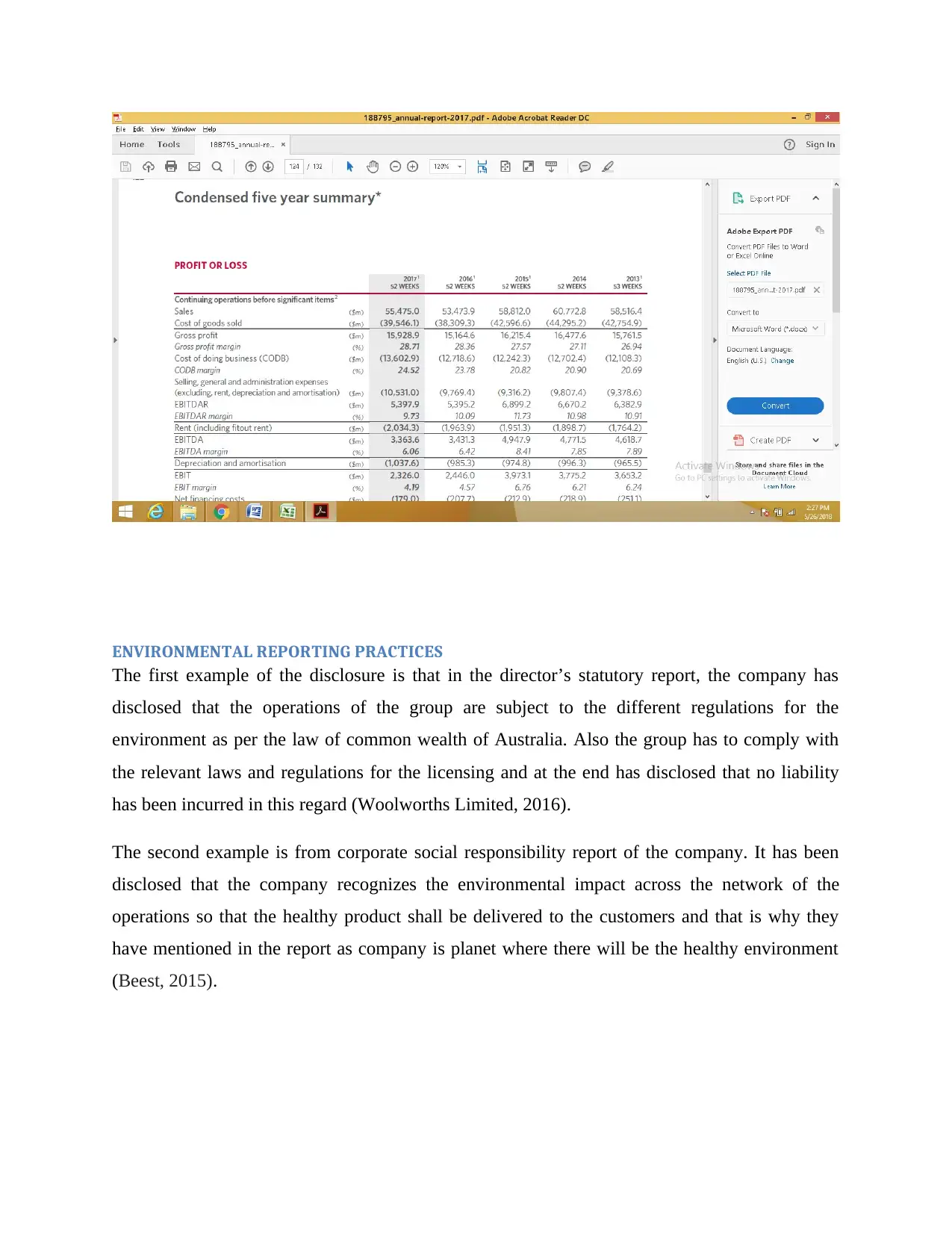
ENVIRONMENTAL REPORTING PRACTICES
The first example of the disclosure is that in the director’s statutory report, the company has
disclosed that the operations of the group are subject to the different regulations for the
environment as per the law of common wealth of Australia. Also the group has to comply with
the relevant laws and regulations for the licensing and at the end has disclosed that no liability
has been incurred in this regard (Woolworths Limited, 2016).
The second example is from corporate social responsibility report of the company. It has been
disclosed that the company recognizes the environmental impact across the network of the
operations so that the healthy product shall be delivered to the customers and that is why they
have mentioned in the report as company is planet where there will be the healthy environment
(Beest, 2015).
The first example of the disclosure is that in the director’s statutory report, the company has
disclosed that the operations of the group are subject to the different regulations for the
environment as per the law of common wealth of Australia. Also the group has to comply with
the relevant laws and regulations for the licensing and at the end has disclosed that no liability
has been incurred in this regard (Woolworths Limited, 2016).
The second example is from corporate social responsibility report of the company. It has been
disclosed that the company recognizes the environmental impact across the network of the
operations so that the healthy product shall be delivered to the customers and that is why they
have mentioned in the report as company is planet where there will be the healthy environment
(Beest, 2015).
⊘ This is a preview!⊘
Do you want full access?
Subscribe today to unlock all pages.

Trusted by 1+ million students worldwide
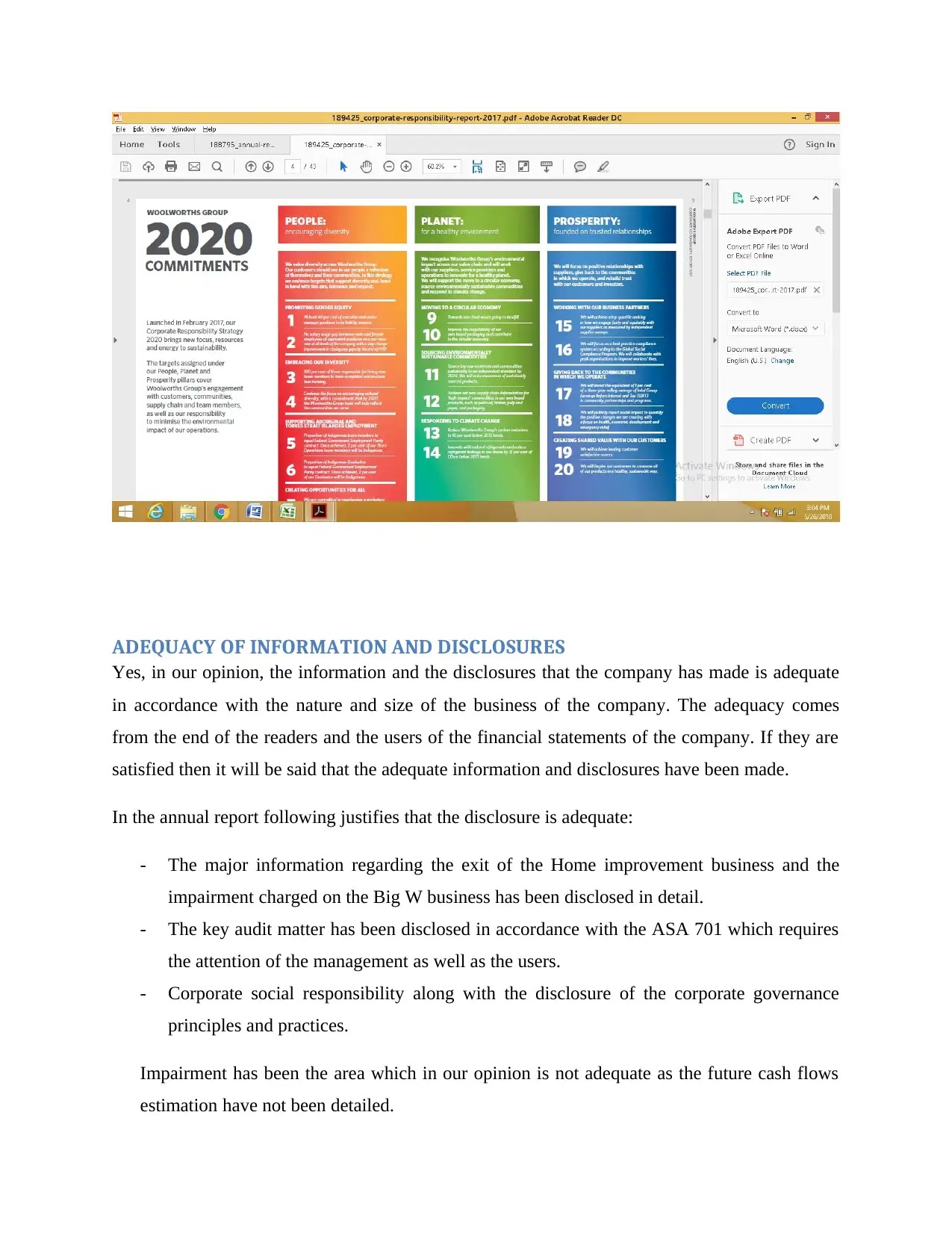
ADEQUACY OF INFORMATION AND DISCLOSURES
Yes, in our opinion, the information and the disclosures that the company has made is adequate
in accordance with the nature and size of the business of the company. The adequacy comes
from the end of the readers and the users of the financial statements of the company. If they are
satisfied then it will be said that the adequate information and disclosures have been made.
In the annual report following justifies that the disclosure is adequate:
- The major information regarding the exit of the Home improvement business and the
impairment charged on the Big W business has been disclosed in detail.
- The key audit matter has been disclosed in accordance with the ASA 701 which requires
the attention of the management as well as the users.
- Corporate social responsibility along with the disclosure of the corporate governance
principles and practices.
Impairment has been the area which in our opinion is not adequate as the future cash flows
estimation have not been detailed.
Yes, in our opinion, the information and the disclosures that the company has made is adequate
in accordance with the nature and size of the business of the company. The adequacy comes
from the end of the readers and the users of the financial statements of the company. If they are
satisfied then it will be said that the adequate information and disclosures have been made.
In the annual report following justifies that the disclosure is adequate:
- The major information regarding the exit of the Home improvement business and the
impairment charged on the Big W business has been disclosed in detail.
- The key audit matter has been disclosed in accordance with the ASA 701 which requires
the attention of the management as well as the users.
- Corporate social responsibility along with the disclosure of the corporate governance
principles and practices.
Impairment has been the area which in our opinion is not adequate as the future cash flows
estimation have not been detailed.
Paraphrase This Document
Need a fresh take? Get an instant paraphrase of this document with our AI Paraphraser
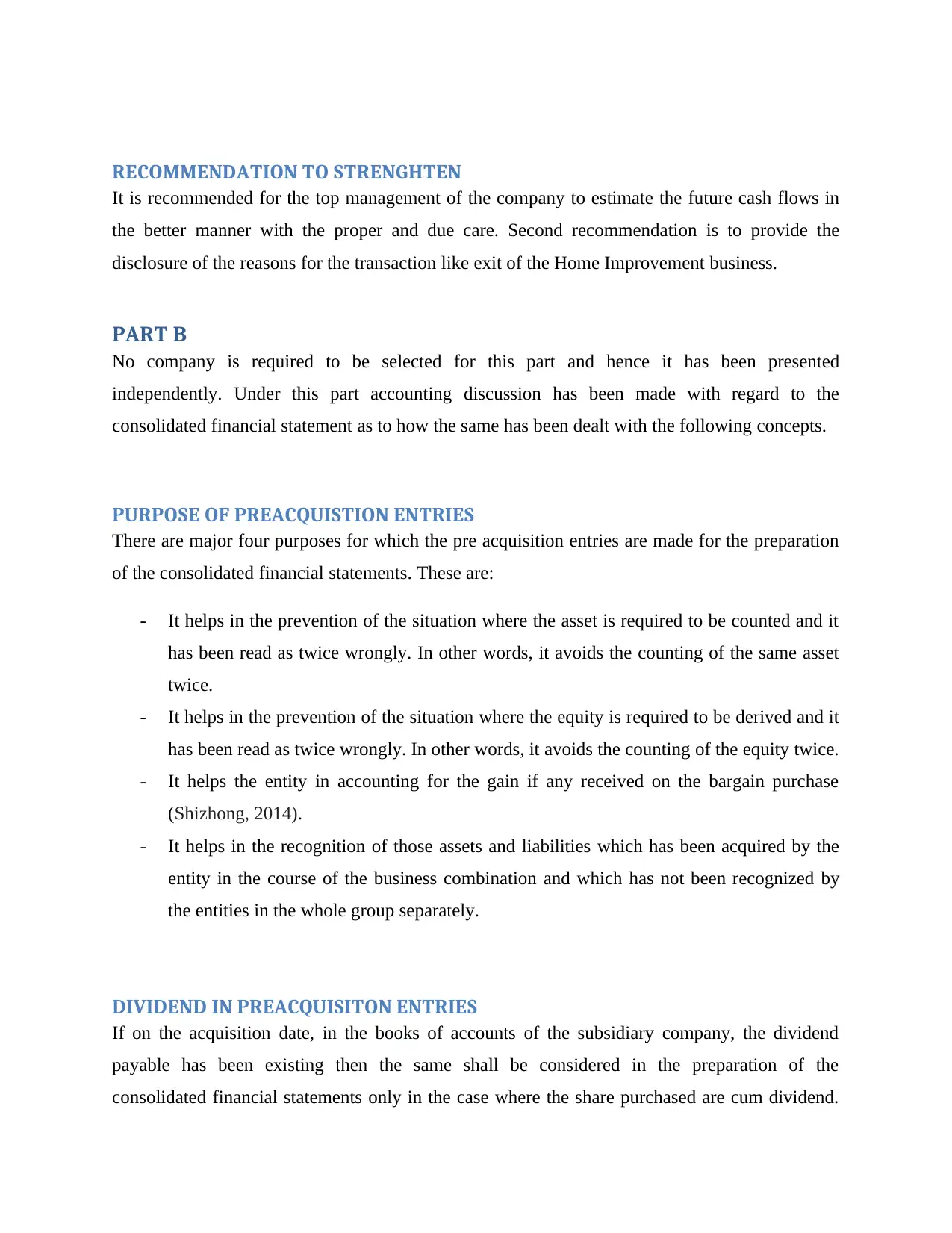
RECOMMENDATION TO STRENGHTEN
It is recommended for the top management of the company to estimate the future cash flows in
the better manner with the proper and due care. Second recommendation is to provide the
disclosure of the reasons for the transaction like exit of the Home Improvement business.
PART B
No company is required to be selected for this part and hence it has been presented
independently. Under this part accounting discussion has been made with regard to the
consolidated financial statement as to how the same has been dealt with the following concepts.
PURPOSE OF PREACQUISTION ENTRIES
There are major four purposes for which the pre acquisition entries are made for the preparation
of the consolidated financial statements. These are:
- It helps in the prevention of the situation where the asset is required to be counted and it
has been read as twice wrongly. In other words, it avoids the counting of the same asset
twice.
- It helps in the prevention of the situation where the equity is required to be derived and it
has been read as twice wrongly. In other words, it avoids the counting of the equity twice.
- It helps the entity in accounting for the gain if any received on the bargain purchase
(Shizhong, 2014).
- It helps in the recognition of those assets and liabilities which has been acquired by the
entity in the course of the business combination and which has not been recognized by
the entities in the whole group separately.
DIVIDEND IN PREACQUISITON ENTRIES
If on the acquisition date, in the books of accounts of the subsidiary company, the dividend
payable has been existing then the same shall be considered in the preparation of the
consolidated financial statements only in the case where the share purchased are cum dividend.
It is recommended for the top management of the company to estimate the future cash flows in
the better manner with the proper and due care. Second recommendation is to provide the
disclosure of the reasons for the transaction like exit of the Home Improvement business.
PART B
No company is required to be selected for this part and hence it has been presented
independently. Under this part accounting discussion has been made with regard to the
consolidated financial statement as to how the same has been dealt with the following concepts.
PURPOSE OF PREACQUISTION ENTRIES
There are major four purposes for which the pre acquisition entries are made for the preparation
of the consolidated financial statements. These are:
- It helps in the prevention of the situation where the asset is required to be counted and it
has been read as twice wrongly. In other words, it avoids the counting of the same asset
twice.
- It helps in the prevention of the situation where the equity is required to be derived and it
has been read as twice wrongly. In other words, it avoids the counting of the equity twice.
- It helps the entity in accounting for the gain if any received on the bargain purchase
(Shizhong, 2014).
- It helps in the recognition of those assets and liabilities which has been acquired by the
entity in the course of the business combination and which has not been recognized by
the entities in the whole group separately.
DIVIDEND IN PREACQUISITON ENTRIES
If on the acquisition date, in the books of accounts of the subsidiary company, the dividend
payable has been existing then the same shall be considered in the preparation of the
consolidated financial statements only in the case where the share purchased are cum dividend.
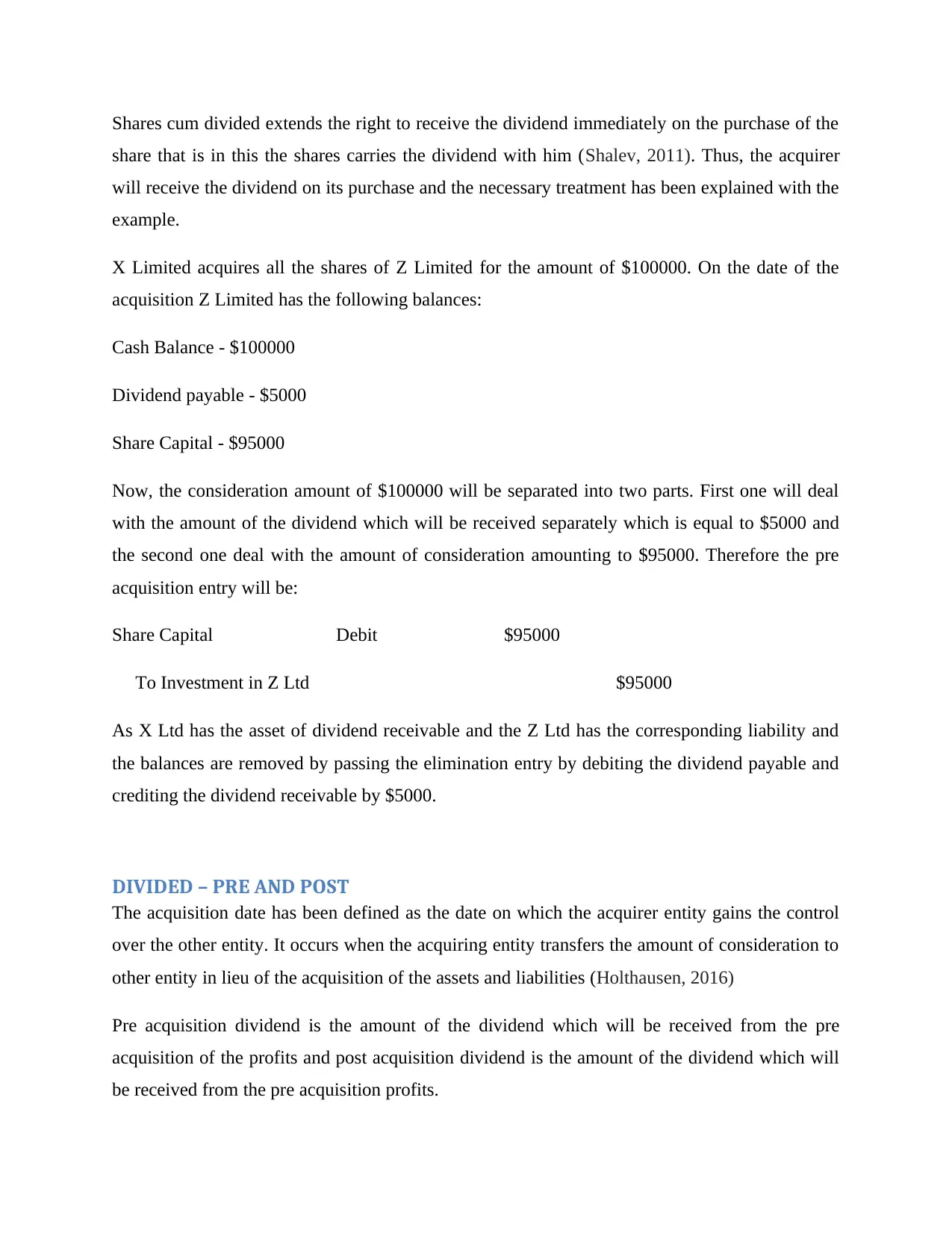
Shares cum divided extends the right to receive the dividend immediately on the purchase of the
share that is in this the shares carries the dividend with him (Shalev, 2011). Thus, the acquirer
will receive the dividend on its purchase and the necessary treatment has been explained with the
example.
X Limited acquires all the shares of Z Limited for the amount of $100000. On the date of the
acquisition Z Limited has the following balances:
Cash Balance - $100000
Dividend payable - $5000
Share Capital - $95000
Now, the consideration amount of $100000 will be separated into two parts. First one will deal
with the amount of the dividend which will be received separately which is equal to $5000 and
the second one deal with the amount of consideration amounting to $95000. Therefore the pre
acquisition entry will be:
Share Capital Debit $95000
To Investment in Z Ltd $95000
As X Ltd has the asset of dividend receivable and the Z Ltd has the corresponding liability and
the balances are removed by passing the elimination entry by debiting the dividend payable and
crediting the dividend receivable by $5000.
DIVIDED – PRE AND POST
The acquisition date has been defined as the date on which the acquirer entity gains the control
over the other entity. It occurs when the acquiring entity transfers the amount of consideration to
other entity in lieu of the acquisition of the assets and liabilities (Holthausen, 2016)
Pre acquisition dividend is the amount of the dividend which will be received from the pre
acquisition of the profits and post acquisition dividend is the amount of the dividend which will
be received from the pre acquisition profits.
share that is in this the shares carries the dividend with him (Shalev, 2011). Thus, the acquirer
will receive the dividend on its purchase and the necessary treatment has been explained with the
example.
X Limited acquires all the shares of Z Limited for the amount of $100000. On the date of the
acquisition Z Limited has the following balances:
Cash Balance - $100000
Dividend payable - $5000
Share Capital - $95000
Now, the consideration amount of $100000 will be separated into two parts. First one will deal
with the amount of the dividend which will be received separately which is equal to $5000 and
the second one deal with the amount of consideration amounting to $95000. Therefore the pre
acquisition entry will be:
Share Capital Debit $95000
To Investment in Z Ltd $95000
As X Ltd has the asset of dividend receivable and the Z Ltd has the corresponding liability and
the balances are removed by passing the elimination entry by debiting the dividend payable and
crediting the dividend receivable by $5000.
DIVIDED – PRE AND POST
The acquisition date has been defined as the date on which the acquirer entity gains the control
over the other entity. It occurs when the acquiring entity transfers the amount of consideration to
other entity in lieu of the acquisition of the assets and liabilities (Holthausen, 2016)
Pre acquisition dividend is the amount of the dividend which will be received from the pre
acquisition of the profits and post acquisition dividend is the amount of the dividend which will
be received from the pre acquisition profits.
⊘ This is a preview!⊘
Do you want full access?
Subscribe today to unlock all pages.

Trusted by 1+ million students worldwide
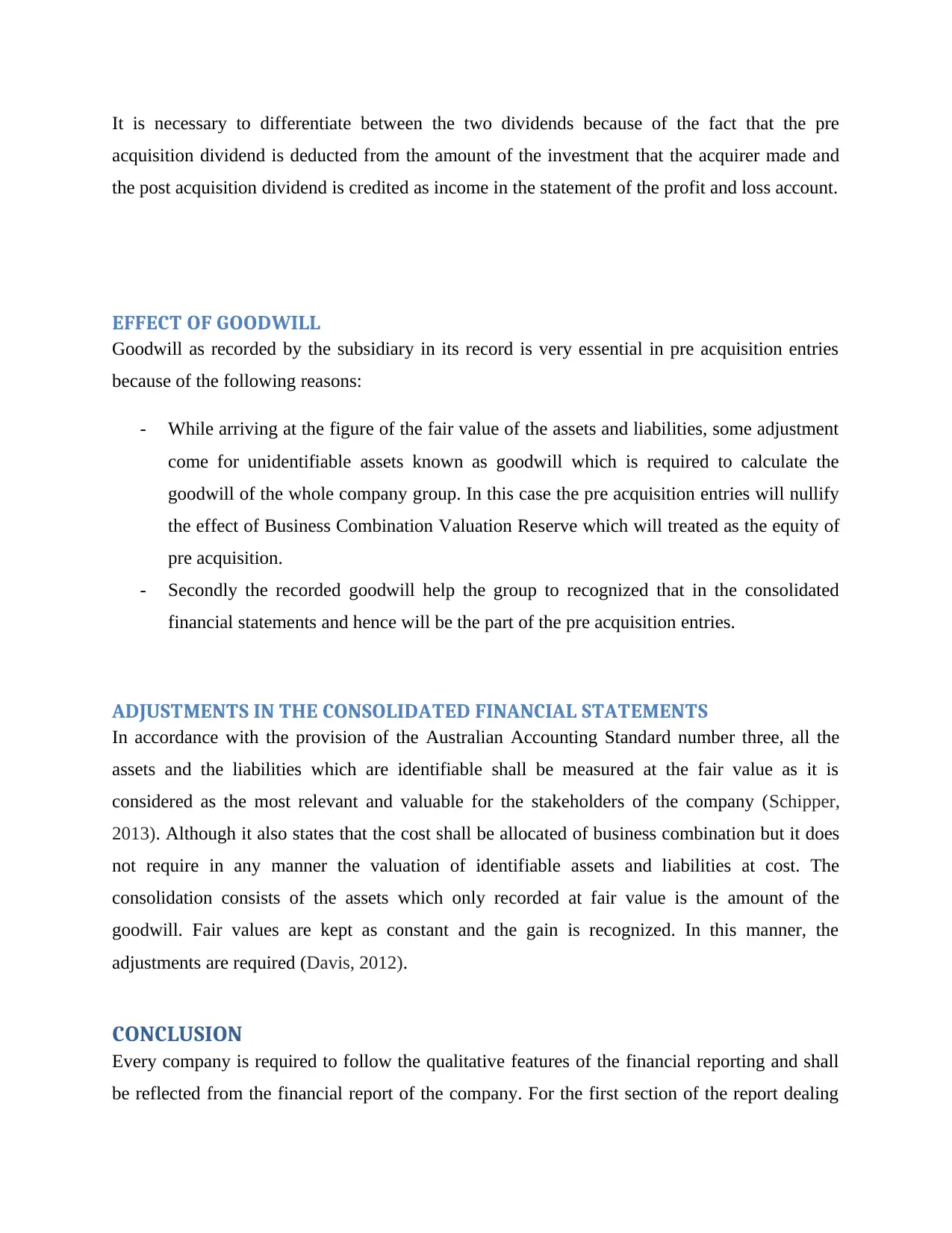
It is necessary to differentiate between the two dividends because of the fact that the pre
acquisition dividend is deducted from the amount of the investment that the acquirer made and
the post acquisition dividend is credited as income in the statement of the profit and loss account.
EFFECT OF GOODWILL
Goodwill as recorded by the subsidiary in its record is very essential in pre acquisition entries
because of the following reasons:
- While arriving at the figure of the fair value of the assets and liabilities, some adjustment
come for unidentifiable assets known as goodwill which is required to calculate the
goodwill of the whole company group. In this case the pre acquisition entries will nullify
the effect of Business Combination Valuation Reserve which will treated as the equity of
pre acquisition.
- Secondly the recorded goodwill help the group to recognized that in the consolidated
financial statements and hence will be the part of the pre acquisition entries.
ADJUSTMENTS IN THE CONSOLIDATED FINANCIAL STATEMENTS
In accordance with the provision of the Australian Accounting Standard number three, all the
assets and the liabilities which are identifiable shall be measured at the fair value as it is
considered as the most relevant and valuable for the stakeholders of the company (Schipper,
2013). Although it also states that the cost shall be allocated of business combination but it does
not require in any manner the valuation of identifiable assets and liabilities at cost. The
consolidation consists of the assets which only recorded at fair value is the amount of the
goodwill. Fair values are kept as constant and the gain is recognized. In this manner, the
adjustments are required (Davis, 2012).
CONCLUSION
Every company is required to follow the qualitative features of the financial reporting and shall
be reflected from the financial report of the company. For the first section of the report dealing
acquisition dividend is deducted from the amount of the investment that the acquirer made and
the post acquisition dividend is credited as income in the statement of the profit and loss account.
EFFECT OF GOODWILL
Goodwill as recorded by the subsidiary in its record is very essential in pre acquisition entries
because of the following reasons:
- While arriving at the figure of the fair value of the assets and liabilities, some adjustment
come for unidentifiable assets known as goodwill which is required to calculate the
goodwill of the whole company group. In this case the pre acquisition entries will nullify
the effect of Business Combination Valuation Reserve which will treated as the equity of
pre acquisition.
- Secondly the recorded goodwill help the group to recognized that in the consolidated
financial statements and hence will be the part of the pre acquisition entries.
ADJUSTMENTS IN THE CONSOLIDATED FINANCIAL STATEMENTS
In accordance with the provision of the Australian Accounting Standard number three, all the
assets and the liabilities which are identifiable shall be measured at the fair value as it is
considered as the most relevant and valuable for the stakeholders of the company (Schipper,
2013). Although it also states that the cost shall be allocated of business combination but it does
not require in any manner the valuation of identifiable assets and liabilities at cost. The
consolidation consists of the assets which only recorded at fair value is the amount of the
goodwill. Fair values are kept as constant and the gain is recognized. In this manner, the
adjustments are required (Davis, 2012).
CONCLUSION
Every company is required to follow the qualitative features of the financial reporting and shall
be reflected from the financial report of the company. For the first section of the report dealing
Paraphrase This Document
Need a fresh take? Get an instant paraphrase of this document with our AI Paraphraser
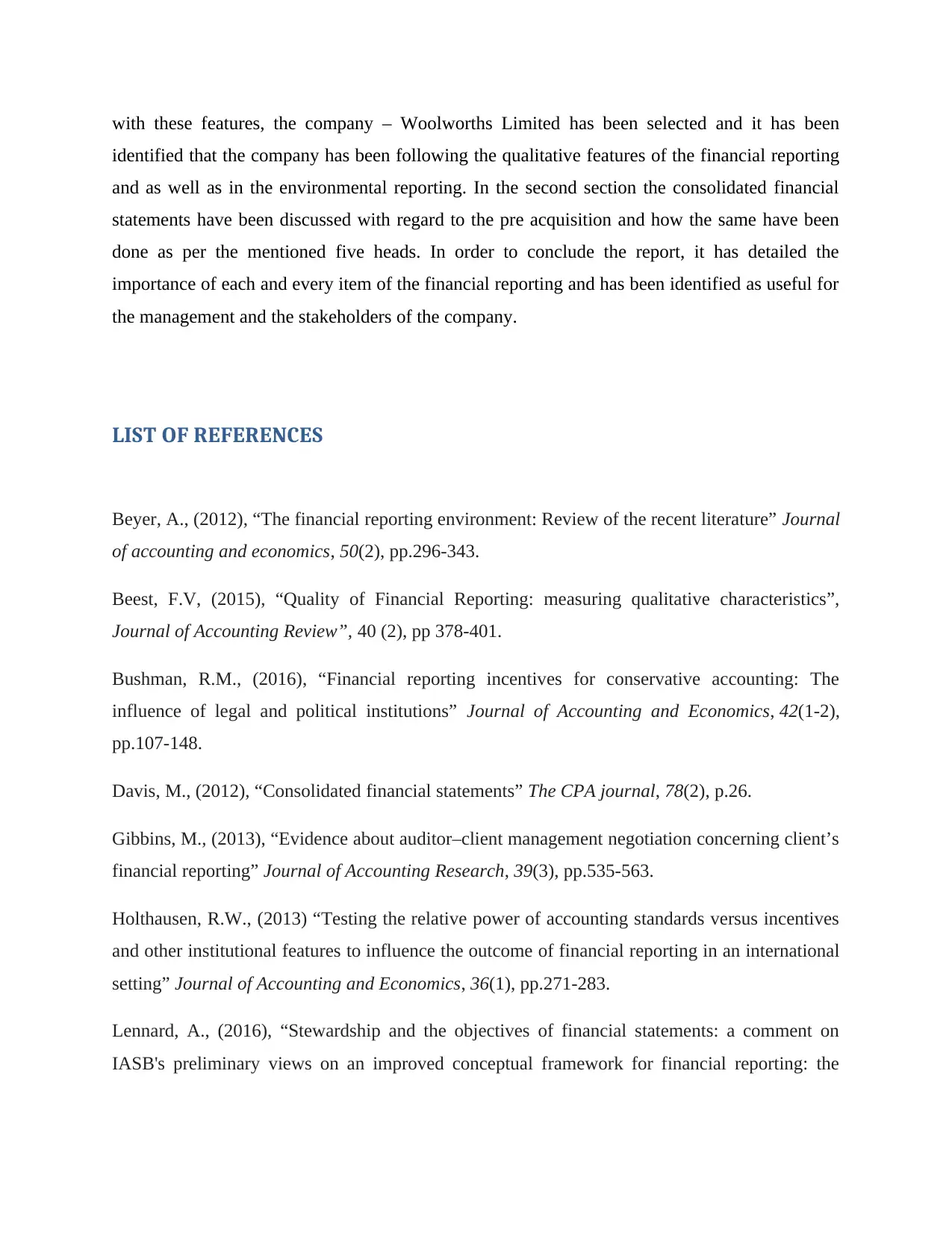
with these features, the company – Woolworths Limited has been selected and it has been
identified that the company has been following the qualitative features of the financial reporting
and as well as in the environmental reporting. In the second section the consolidated financial
statements have been discussed with regard to the pre acquisition and how the same have been
done as per the mentioned five heads. In order to conclude the report, it has detailed the
importance of each and every item of the financial reporting and has been identified as useful for
the management and the stakeholders of the company.
LIST OF REFERENCES
Beyer, A., (2012), “The financial reporting environment: Review of the recent literature” Journal
of accounting and economics, 50(2), pp.296-343.
Beest, F.V, (2015), “Quality of Financial Reporting: measuring qualitative characteristics”,
Journal of Accounting Review”, 40 (2), pp 378-401.
Bushman, R.M., (2016), “Financial reporting incentives for conservative accounting: The
influence of legal and political institutions” Journal of Accounting and Economics, 42(1-2),
pp.107-148.
Davis, M., (2012), “Consolidated financial statements” The CPA journal, 78(2), p.26.
Gibbins, M., (2013), “Evidence about auditor–client management negotiation concerning client’s
financial reporting” Journal of Accounting Research, 39(3), pp.535-563.
Holthausen, R.W., (2013) “Testing the relative power of accounting standards versus incentives
and other institutional features to influence the outcome of financial reporting in an international
setting” Journal of Accounting and Economics, 36(1), pp.271-283.
Lennard, A., (2016), “Stewardship and the objectives of financial statements: a comment on
IASB's preliminary views on an improved conceptual framework for financial reporting: the
identified that the company has been following the qualitative features of the financial reporting
and as well as in the environmental reporting. In the second section the consolidated financial
statements have been discussed with regard to the pre acquisition and how the same have been
done as per the mentioned five heads. In order to conclude the report, it has detailed the
importance of each and every item of the financial reporting and has been identified as useful for
the management and the stakeholders of the company.
LIST OF REFERENCES
Beyer, A., (2012), “The financial reporting environment: Review of the recent literature” Journal
of accounting and economics, 50(2), pp.296-343.
Beest, F.V, (2015), “Quality of Financial Reporting: measuring qualitative characteristics”,
Journal of Accounting Review”, 40 (2), pp 378-401.
Bushman, R.M., (2016), “Financial reporting incentives for conservative accounting: The
influence of legal and political institutions” Journal of Accounting and Economics, 42(1-2),
pp.107-148.
Davis, M., (2012), “Consolidated financial statements” The CPA journal, 78(2), p.26.
Gibbins, M., (2013), “Evidence about auditor–client management negotiation concerning client’s
financial reporting” Journal of Accounting Research, 39(3), pp.535-563.
Holthausen, R.W., (2013) “Testing the relative power of accounting standards versus incentives
and other institutional features to influence the outcome of financial reporting in an international
setting” Journal of Accounting and Economics, 36(1), pp.271-283.
Lennard, A., (2016), “Stewardship and the objectives of financial statements: a comment on
IASB's preliminary views on an improved conceptual framework for financial reporting: the
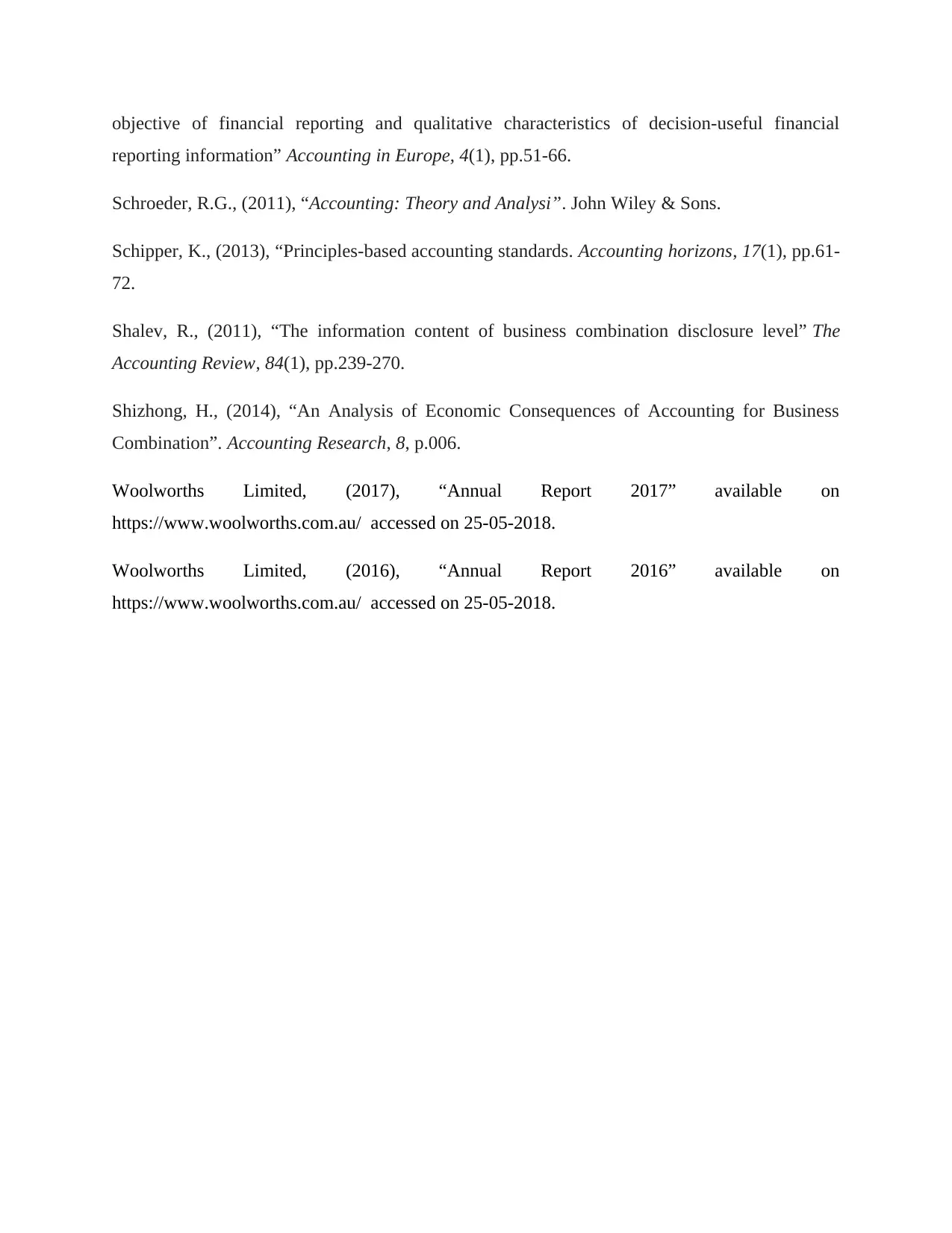
objective of financial reporting and qualitative characteristics of decision-useful financial
reporting information” Accounting in Europe, 4(1), pp.51-66.
Schroeder, R.G., (2011), “Accounting: Theory and Analysi”. John Wiley & Sons.
Schipper, K., (2013), “Principles-based accounting standards. Accounting horizons, 17(1), pp.61-
72.
Shalev, R., (2011), “The information content of business combination disclosure level” The
Accounting Review, 84(1), pp.239-270.
Shizhong, H., (2014), “An Analysis of Economic Consequences of Accounting for Business
Combination”. Accounting Research, 8, p.006.
Woolworths Limited, (2017), “Annual Report 2017” available on
https://www.woolworths.com.au/ accessed on 25-05-2018.
Woolworths Limited, (2016), “Annual Report 2016” available on
https://www.woolworths.com.au/ accessed on 25-05-2018.
reporting information” Accounting in Europe, 4(1), pp.51-66.
Schroeder, R.G., (2011), “Accounting: Theory and Analysi”. John Wiley & Sons.
Schipper, K., (2013), “Principles-based accounting standards. Accounting horizons, 17(1), pp.61-
72.
Shalev, R., (2011), “The information content of business combination disclosure level” The
Accounting Review, 84(1), pp.239-270.
Shizhong, H., (2014), “An Analysis of Economic Consequences of Accounting for Business
Combination”. Accounting Research, 8, p.006.
Woolworths Limited, (2017), “Annual Report 2017” available on
https://www.woolworths.com.au/ accessed on 25-05-2018.
Woolworths Limited, (2016), “Annual Report 2016” available on
https://www.woolworths.com.au/ accessed on 25-05-2018.
⊘ This is a preview!⊘
Do you want full access?
Subscribe today to unlock all pages.

Trusted by 1+ million students worldwide
1 out of 12
Related Documents
Your All-in-One AI-Powered Toolkit for Academic Success.
+13062052269
info@desklib.com
Available 24*7 on WhatsApp / Email
![[object Object]](/_next/static/media/star-bottom.7253800d.svg)
Unlock your academic potential
Copyright © 2020–2025 A2Z Services. All Rights Reserved. Developed and managed by ZUCOL.





